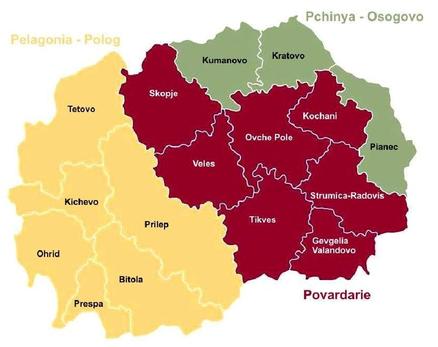 Republic of Macedonia - Geographical Position at Balkan Peninsula
Republic of Macedonia - Geographical Position at Balkan Peninsula
Macedonia, country in the central Balkans, bordered by Bulgaria, Serbia, Kosovo, Albania, Greece, officially the Republic of Macedonia but still described by the UN as FYROM (Former Yugoslav Republic of Macedonia) due to an ongoing dispute over the name Macedonia, which Greece has registered as a PGI. The geographical and historical region of Macedonia covers a much larger area, including parts of Greece and south-western Bulgaria. At one time, under the rule of Philip II (359 bc) and then his son Alexander the Great (until his early death in 323 bc), it was the most powerful state in the world. By 146 bc it had been defeated and became a Roman province. Like the rest of the Balkans, Macedonia came under Ottoman rule for five centuries until 1913. The region of Macedonia was then partitioned between Bulgaria, Greece, and Serbia (this last part went on to become today’s republic).
After the Second World War, Macedonia became part of the Kingdom of Serbs, Croats, and Slovenes, later to become part of Yugoslavia. Secession from Yugoslavia was recognized in 1992, and Macedonia largely avoided the intra-ethnic bloodshed that afflicted so many of its neighbours. A rebel uprising in 2001 was brought to a relatively peaceful conclusion, with increased recognition for the ethnic Albanians, who make up about a quarter of the population. The Republic of Macedonia became an EU candidate country in 2005 although progress towards membership is hampered by the dispute with Greece over names.
The Republic of Macedonia lies between the latitudes of 40 to 43 degrees north. It is landlocked and geographically defined by a central valley formed by the Vardar River Valley, while mountains border the country, with 16 peaks over 2,000 m (6,562 ft). To the south lie three lakes including the UNESCO-listed Lake Ohrid, believed to be one of the oldest lakes in the world. The country is seismically active and the climate is transitional from mediterranean to continental. Hot, dry summers with 270 sunny days are typical and annual rainfall ranges from 500 mm/ 20 in in the centre to 1,700 mm/ 70 in in the mountains, making it the driest region in the Balkans. The grape-growing regions are sufficiently hot that acidification but not enrichment is allowed. Wine is a significant crop in Macedonia, and is the second most important agricultural export after tobacco. In the 1980s Macedonia accounted for as much as two-thirds of Yugoslavia’s wine production, reaching a peak of 1.8 million hl/ 47.5 million gal in the early 1990s. Production has fallen since but by 2013 had recovered to around 1.2 million hl. Two-thirds of this was exported, mainly as cheap bulk wine and chiefly to Germany. Accurate information about vineyard area and varieties is elusive but the best estimate in 2013 was about 23,500 ha/ 58,070 acres planted to wine grapes. In 2013, there were 81 registered wineries of which 90% had a capacity of under 50,000 hl/ 1.3 million gal, but there were four very large wineries producing 150,000 to 500,000 hl of wine a year.
|
There are 16 wine districts within three wine regions: Pcinya-Osogovo in the east, the western region of Pelagoniya-Polog, and the most important central region of Vardar River Valley (also known as Povardarie), which accounts for more than 85% of vineyard area, particularly the Tikveš district, location of 41% of the country’s vineyards. Recent investment in large, modern wineries and new vineyards has been substantial and some foreign consultants have been drafted in to modernize winemaking. A number of smaller estates and premium boutique wineries have also appeared, and there is increasing interest in vineyards at higher elevations in the steep hills close to the border with Greece, for example— all indications of the growing emphasis on quality over quantity. Red wine varieties predominate, particularly Vranec.
|
Stanušina and Ohridsko Crno, are the only genuinely indigenous variety so far identified. Other red varieties include Kratošija (Tribidrag or Zinfandel), Cabernet Sauvignon, Merlot, Syrah, and even some promising Petit Verdot. overripeness and high alcohol levels are becoming much less common than in the past, although producers suggest that Vranec has to reach 14% to reveal its rich fruit flavours. White wine grapes are generally destined for brandy or rakija production although dry whites are starting to show promise thanks to more sophisticated winemaking. They include Žilavka, Župljanka, Temjanika (Muscat Blanc à Petit Grains), Smederevka, Rkatsiteli, Graševina (Welschriesling), Chardonnay, and Sauvignon Blanc.
Dr Caroline Gilby MW


